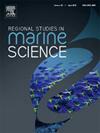Coastal vegetation response to land uplift inflicted sea level drop in the North Andaman Islands, India
IF 2.1
4区 环境科学与生态学
Q3 ECOLOGY
引用次数: 0
Abstract
The permanent retrieval of tidal water due to coastal uplift post the 2004 tsunami caused a drop in mean sea level significantly degrading the mangroves of North Andaman and Mayabunder region (135 km2). Meanwhile, the exposed reef bed in the uplifted sites provided an opportunity for the seaward expansion of mangroves, while the degraded mangroves provided an opportunity for the expansion of terrestrial forests. This study examines vegetation succession in three distinct vegetation categories formed due to geomorphological changes: New Terrestrial Forest (NTF) where terrestrial vegetation now occupies former mangrove areas, Old Mangrove Forest (OMF) with altered tidal regimes but retained mangrove status, and New Mangrove Forest (NMF) growing on former reef beds. A total of 257 plots (10 ×10 m2) across 27 sites (nine/vegetation type) were established to study the vegetation community. NTF sites exhibited the highest species richness (n = 73 species, including nine mangroves), while OMF and NMF sites hold 18 and 10 mangroves respectively. The tree density/plot was lowest in NTF (4.5 ± 0.81), followed by NMF (7.4 ± 1.01), and was highest in OMF (13.2 ± 1.21) sites. Ficus rumphii (15.2 %) was most abundant at NTF; while Avicennia marina (35.07 %) was abundant at NMF and Rhizophora apiculata (39.88 %) was abundant at OMF. A significant difference (p < 0.001) was observed in the species diversity and composition among the vegetation types (OMF, NMF, and NTF), and layers (tree, sapling, and seedling). This study provides a crucial baseline on vegetation succession in the altered coastal ecosystem, underscoring the need for long-term monitoring to assess species competition and community dynamics in these unique successional forests.
求助全文
约1分钟内获得全文
求助全文
来源期刊

Regional Studies in Marine Science
Agricultural and Biological Sciences-Ecology, Evolution, Behavior and Systematics
CiteScore
3.90
自引率
4.80%
发文量
336
审稿时长
69 days
期刊介绍:
REGIONAL STUDIES IN MARINE SCIENCE will publish scientifically sound papers on regional aspects of maritime and marine resources in estuaries, coastal zones, continental shelf, the seas and oceans.
 求助内容:
求助内容: 应助结果提醒方式:
应助结果提醒方式:


